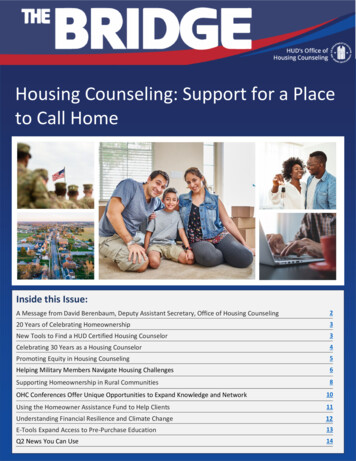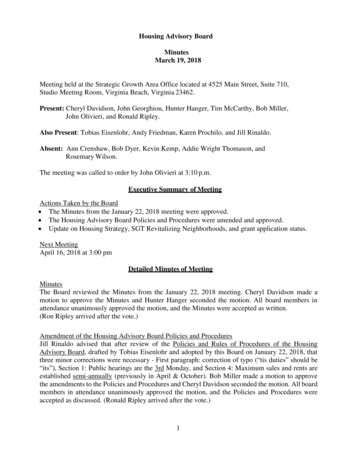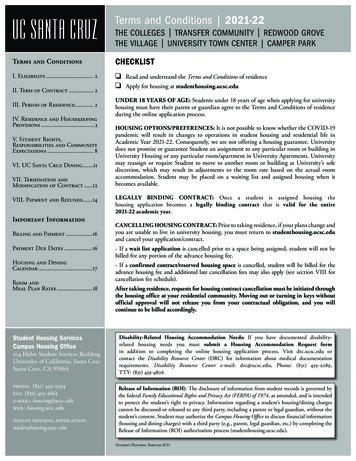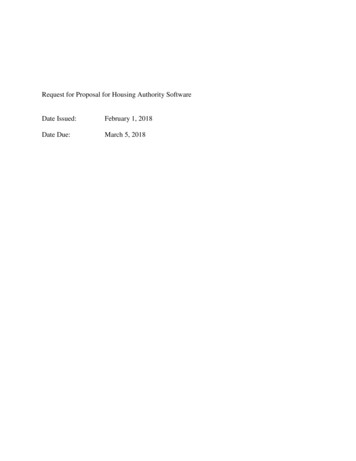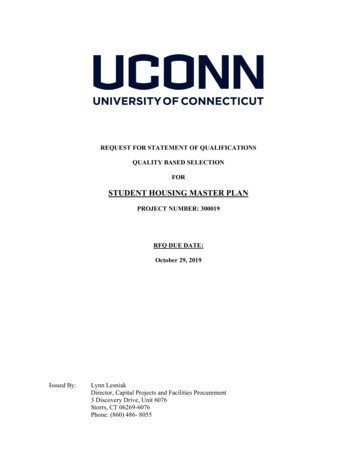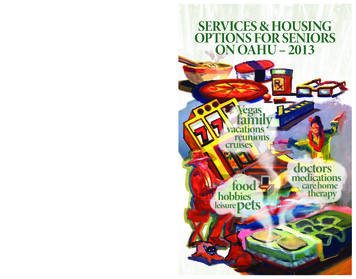
Transcription
SERVICES & HOUSINGOPTIONS FOR SENIORSON OAHU – 2013Kokua Kalihi ValleyComprehensive Family Services2239 N. School StreetHonolulu, HI 96819
SERVICES & HOUSINGOPTIONS FOR SENIORSON OAHU – 2013hmgRitabelle Fernandes, MD, MPH, FACPLate Hortense M. Gandy, MD, MS, FACP, FRACPIn Support of Our Seniors
AcknowledgementsMahalo to Mark Brown for Dreamingand to our associates for their contributions.Copyright 2011 by Ritabelle Fernandes & Hortense M. Gandy. All rights reserved. Nopart of this booklet may be reproduced, stored in a retrieval system, or transmitted, inany form or by any means, electronic, mechanical, photocopying, recording or otherwise,without the written permission of the authors.
CONTENTSPrefaceIntroduction.9I. Aging in Place. 11Home Safety, Fall Prevention, & Universal Design1. Is Your Home Safe?. 142. Does your home need repairs, remodeling, or do youneed to design a new home. 193. Role of Technological & Electronic Devices. 22Finances1. Fraud. 262. Legal Advocacy & Elder Law. 293. Medicare. 314. Medicaid. 335. Social Security. 356. Reverse Mortgage. 377. Long-Term Care Insurance. 39Basics Necessities1. Food. 432. Transportation. 47Respite Care1. In-Home Aides. 512. Adult Day Care & Day Health. 563. Overnight Respite. 634. Chore Services Program. 655. Senior Volunteerism & Job Training. 66
Medical Care1. Geriatricians. 722. Home Health Agencies. 743. Durable Medical Equipment. 754. Hospice. 78Social Services & Support1. Case Management. 802. Kupuna Care. 833. Senior Citizen Centers. 854. Caregiver Support Groups. 87II. Moving On – Other Housing Options. 91Independent Living Facilities. 94Assisted Living Facilities. 101Adult Residential Care Home. 104Foster Homes. 107Nursing Homes. 110III. Future Directions. 115Cohousing. 116Grandfamilies Housing. 116Modular Home Communities. 118Naturally Occurring Retirement Community. 118Senior Villages. 119Veterans Affairs Housing. 119
PREFACEHawaii’s population is aging faster than the Unites States nationalaverage, with a higher life expectancy of 81 years. According to the2010 US Census the fastest growing population in Hawaii are those 85years and older, increasing at a rate of 190.8% between 1990 to 2010,compared with a national increase of 29.6 %. What services will they need? Where will all these seniors live? What housing options are available for seniors now?Many family caregivers and their elders in Hawaii are having problemscurrently finding appropriate housing and/or nursing care due to thelack of available information and the critical shortage of such facilitiesin the state of Hawaii. In view of the increasing senior population,we present a review of information on services and current housingoptions for seniors on Oahu as of 2013.7
INTRODUCTIONAge is not just a number. Normal aging is characterized by physiologicalchanges that affect vision, hearing, taste, muscle strength, bone mass,reaction time, and the ability to cope with changes in stress levels.Some seniors view these changes of normal aging as the end to the joyof independent living. Many active seniors would like to remain rightwhere they are – age in place, even when their needs arise for assistanceand/or supervision. Often the need for the senior to move arrives a littlebefore the senior is ready to give up his or her current home. The finalchoice of housing centers around two options – to move or remain in hisor her current home. The latter choice is referred to as aging in place. Thesenior needs to give some thought to the following questions before theneed to make a decision about his or her living situation arrives. Do I possess independent living skills that include anunderstanding of the concept of time and appropriateuse of a calendar including scheduling of medications? Do I have the capability to take care of personalhygiene and grooming? Does my home provide the best environmentfor my physical needs? Is my home safe? Do I have access to food, transportation, healthcare,and/or help to fulfill my basic needs where I live? Do I have the financial means to sustain me in my current home? Do I understand my legal rights?Often physical changes associated with normal aging force thesenior to look for new housing arrangements. This decision shouldnot be made in haste. A variety of housing options for seniors existon Oahu. Each option is different and must be carefully examined tosee which option best meets the needs of the senior.An understanding of descriptive terminology in relation to evaluatinginformation about types of senior housing facilities and governmentagencies that provide housing assistance programs for seniors is essential inmaking decisions about housing options. www.senioroutlook.com/glossary.asp9
The Hawaii State Board of Education and the Department of Educationhave partnered with Aloha United Way to provide families with helpfinding needed services. Information can be obtained by dialing 211,multilingual assistance is available. www.auw211.orgSeniors and their families looking for community services and housingresources may search for information by state and/or area zip 0
AGINGIN PLACE11
Home represents security and independence to most Americans. Evenseniors with declining health cling to the dream of successful aging inplace. A study by the American Association of Retired Persons (AARP)has revealed that 90% of American seniors wish to age in their respectivehomes. Approximately 26% of seniors fear loss of independence if theymove from the home where they have resided for years. Many seniorsconsider living in safe neighborhoods close to family and friends,medical care, places of worship, and shopping centers as the mostimportant factors in selecting a place to live.Many seniors depend on adult relatives to help pay the bills and/orprovide care that they need. By the age of 65 years, approximately 45% ofAmericans depend on financial assistance from relatives, 30% dependon charities, 23% continue gainful employment until they are no longercapable, but only 2% are financially self-sustaining. Family and friendsprovide majority of all long-term care in Hawaii.According to the 2010 United States (US) Census data, the cost ofmonthly rental of 1,203 in Hawaii topped the national average rentalcost of 842 per month in the other states in the US. Hawaii rated thirdfor renter occupied units spending 30% or more of the householdincome on utilities.Seniors who choose to age in place often need help in identificationof their needs as well as in obtaining help to cope with them. Theseneeds may include safety, security, obtaining meals, transportation,elder law, insurance, finances, case management, health care, exercise,housekeeping services, locating a companion, socialization, spirituality,and/or locating day care. Family, friends, neighbors, and communityorganizations often help the senior to cope with some of these needs.Local service providers that can help seniors fulfill their basic needsare listed in Senior Information and Assistance Handbook 2011-2014published by the Elderly Affairs Division, City and County of Honolulu.A copy is available free of charge from any branch of the AmericanSavings Bank.Elderly Affairs Division (EAD), Department of Community Services,City and County of Honolulu, develops and supports services thatenable older adults to live to their fullest capacity in their respectivehomes and communities through contracts with local service provideragencies. These services include caregiver support, personal care, group12
dining, home delivery of meals, transportation, escort, counseling, legalservices, housing assistance, health, and educational activities.The Hawaii Aging and Disability Resource Center (ADRC) of the ElderlyAffairs Division is a one stop source for information, assistance, andaccess to services and care for older adults, individuals with disability,and family caregivers, telephone: 768-7700. www.hawaiiadrc.orgMore InformationElderly Affairs Division (EAD)715 South King Street, Suite #200Honolulu, HI 96813Senior Helpline: 768-7700Fax: 527-6895www.elderlyaffairs.com13
Home Safety, FallPrevention, ANDUniversal Design1. Is Your Home Safe?Home safety is very important in preventing falls and disabilities. Fallsare the leading cause of injuries among seniors in Hawaii. Every 5hours a senior in Hawaii suffers a fall that results in the senior beinghospitalized. One in three adults 65 years or older in the US suffers a falleach year. Falls can result in bruises, sprains, broken bones, and/or headinjuries Two thirds of non fatal falls occur in women who often sustaina fracture. The number of fatal falls increases steadily as seniors growolder. The number of falls as well as the medical cost associated with themanagement of these falls is collected by the National Institute of Healthand Centers for Disease Control and Prevention.Some falls can be prevented by use of the following. Non-slip flooring. Installation of stair railing and/or stair climber. Eliminating area rugs that shift or curl. De-cluttering the living spaces and footpaths throughout the home. Providing a roll-in or curb-less shower stall. Installing grab bars in the shower and tub areas. Appropriate height toilet seat. Lights in hallways as well as closets. Replacing door knobs and faucets with lever type handles. Increasing the width of doorways to 32 inches or moreto accommodate the use of a wheelchair or walker. Installation of a smoke detector and fire extinguisheraccording to code. Setting of hot water heater thermostat at 110 F or lower.Home safety evaluations conducted by a physical therapist or anoccupational therapist along with a qualified building industryprofessional designer, architect, builder, or contractor are invaluablein the prevention of falls. Table 1 lists organizations offering homesafety evaluations.14
Cost: No charge for home safety evaluations by medical insurance, if theevaluation is prescribed by a physician.Table 1 – Organizations Offering Home Safety EvaluationEast Oahu Physical Therapy850 West Hind Drive, Suite #201Honolulu, HI 96821www.eastoahuphysicaltherapy.com377-5605Elam Sports Oahu91-1027 Shangrila Street, #1867Kapolei HI 96707www.elamsports.com674-9595Kaiser Permanente Home Health(Kaiser members only)Mapunapuna Clinic2828 Paa StreetHonolulu, HI 96819www.kaiserpermanente.org432-5688Ohana Pacific Rehabilitation Services354 Ulunui Street, #404Kailua, HI 96734www.ohanapacificrehab.com262-1118OT to You, LLCP.O. Box 4559Honolulu, HI 96812347-1969Project Dana (Volunteer program)2720 Nakookoo StreetHonolulu, HI 96826www.projectdana.org945-373615
Rehab at NuuanuRehabilitation Hospital of the Pacific226 North Kuakini StreetHonolulu, HI 96817www.rehabhospital.org544-3310StayFit Physical Therapy99-128 Aiea Height Drive, #207Aiea, HI 96701487-0487Therapists On Call46-310 Hoauna StreetKaneohe, HI 96744247-2472Falls can be caused by many factors which are associated with healthand aging conditions. Predictors of falls include a previous fall, poorposture, poor balance, prolonged bed rest, muscle weakness, mobilityproblems, loss of sensation in the feet, vision changes, dehydration,and drug interactions. Review of vision of the senior, his or her useof physician prescribed and over the counter medications, alcoholconsumption, and marijuana use, may provide information that canbe useful in decreasing the occurrence of falls. Senior participationin community fall prevention exercise programs and educationalclasses shown in Table 2 help prevent in-home falls. Most of theseprevention programs and classes are free of charge, others charge anominal fee. Seniors need to inquire at their local churches, manyare beginning to offer exercise and wellness programs free of charge.Healthy Aging Partnership between Executive Office on Agingand community partners offer evidence-based health promotionand disease prevention programs. The Ke Ola Pono disease selfmanagement programs include chronic disease self-management,arthritis self-management, and diabetes self-management. To learnmore about accessing these classes contact the Honolulu county officeon aging, telephone: 768-7705.16
Table 2 – Fall Prevention Exercise & Educational ProgramsAction Rehab863 Halekauwila StreetHonolulu, HI 96813www.actionrehabhawaii.org597-1555Arthritis Foundation Exercise Program615 Piikoi Street, Suite #1109Honolulu, HI 96814www.arthritis.org596-2900Arcadia Retirement Residence (Residents only)1434 Punahou StreetHonolulu, HI 96822www.arcadia-hi.org941-0941CFS Gerontology Program: No Fear of Falling200 North Vineyard Boulevard, Building BHonolulu, HI 96817www.childandfamilyservice.org543-8468Castle Wellness and Lifestyle Medicine Center642 Ulukahiki StreeT, Suite #105Kailua, HI 96734www.castlemed.org263-5400Department of Parks and RecreationTherapeutic Recreation Unit1000 Uluohia Street, Suite #309Kapolei, HI 96707www.honolulu.gov/parks768-3027Hawaii Academy1314 Mo’onui StreetHonolulu, HI 96817www.hawaiiacademy.com842-564217
HMSA Wellbeing Connection818 Keeaumoku StreetHonolulu, HI 96814www.hmsa.com948-6398Kaiser Permanente (Kaiser members only)1010 Pensacola Street, 3rd FloorHonolulu, HI 96814www.kaiserpermanente.org432-2270Kokua Kalihi Valley Comprehensive FamilyServices (Kalihi Valley residents only)1846 Gulick AvenueHonolulu, HI 96819www.kkv.net848-0977Pohai Nani Good Samaritan45-090 Namoku StreetKaneohe, HI 96744www.pohainani.org247-3448YMCA401 Atkinson DriveHonolulu, HI 96814www.ymcahonolulu.org941-3324YWCA1040 Richards StreetHonolulu, HI 96813www.ywca.org/oahu538-7061More Information Alcoholic Anonymous, www.alcoholicsanonymous.com Centers for Disease Control and Prevention, Falls older index.html Fall Prevention Center of Excellence, www.stopfalls.org Fall Prevention Resource Guide, available on line revention/PDF/fallsprevguide.pdf18
2. Does your home need repairs, remodelingor do you need to design a new home?Making timely home repairs as well as regular general maintenance helpto prevent in-home accidents as well as increase the monetary value ofthe property. The senior should first list his or her repair needs and/or remodeling desires. Consultation with a Certified Aging-In-PlaceSpecialist (CAPS) can be helpful in planning modification of the hometo better meet the needs of the senior. A list of CAPS building industryprofessionals can be found at National Association of Home Builders,www.nahb.org/directory.aspx?sectionID 126&directoryID 188Modifications such as the widening of the doorways, increasing lightingin hallways, and installing grab bars in bathrooms, increases themobility and safety of the active senior. Proper use of assistive devicesby the senior using a cane, walker, or wheelchair is important. Kitchenappliances should conform to the height and physical abilities of theuser and include safety features that accommodate tolerance for errorssuch as automatic turn-off mechanisms when left unattended. Theinstallation of roll out shelves or drawers in lower cabinets can reducebending and make access easier. The use of C or D shaped handles oncabinet doors and drawers allow any user to open and close the drawerwith ease. Modifications should allow the senior to continue to safelyperform essential activities of daily living such as bathing, cooking,housework, and climbing stairs.In event that the senior needs to select and/or plan a new home, a reviewof Universal design principles and applications can be helpful in findingand/or designing a safer and more comfortable home that better meetsthe needs of the aging senior. Universal design refers to a broad spectrumsolution that produces environments that are usable and effective foreveryone including the aging senior and persons with disabilities.Universal design offers features such as zero step entry, one level living,sufficiently wide doorways and hallways, sufficient circulation space, andclosets with adjustable shelving, hanging space, and storage. Companiesspecializing in Universal design home renovations are listed in Table 3.Special Programs: The Ohana Housing Program created in 1981 permitsthe placement of a second dwelling on residential lots with adequatepublic facilities such as water, sewer, and parking. This small separatemanufactured home is placed in the yard by the side of a single familyhouse. Ohana dwelling units are not permitted on lots within a zero-lot19
line project, cluster housing projects, agricultural clusters, county clusters,or on duplex unit lots. Such low cost houses are designed to be movable andreusable. Ohana housing enables aging parents to live in close proximityto their children, but not with them. The concept of Ohana Housing iscalled Elder Cottage Housing Opportunities (ECHO) on the mainland.Energy Solutions Outreach Program provides free energy efficient items tolow income families. These include compact fluorescent light bulbs, faucetaerators, low-flow shower heads, and water heater set backs. These itemsare installed by a Hawaiian Electric Company (HECO) representative.This program is administered by the Honolulu Community ActionProgram (HCAP), telephone: 521-4531. www.hcapweb.orgWeatherization Assistance Program (WAP) provides free compactfluorescent light bulbs, solar water heating systems, low-flow shower heads,and energy conservation education free of charge to low income individualsand families. This program is funded by the American Recovery andReinvestment Act, the US Department of Energy and the State of HawaiiOffice of Community Services. WAP is offered by HCAP. To apply, contactthe HCAP district center nearest to you. www.hcapweb.orgLoans and Subsidies: Home repair loans are available from City andCounty Rehabilitative Loans, 51 Merchant Street, 1st floor, Honolulu,HI, 96813, telephone: 768-7076. This agency also offers disaster assistance,sewer connection, and solar roof loan programs.Seniors with a low income residing in rural areas may obtain funds forhome improvement by way of a Rural Development Grant from the USDepartment of Agriculture, 99-193 Aiea Heights Drive #156, Aiea,HI, 96701, telephone: 483-8600 ext 4. www.rurdev.usda.gov/hiTelephone subsidies for low income individuals are available from HawaiianTelcom Lifeline/ Link-Up Service, P.O. Box 2200, Honolulu, HI, 96814,telephone: 643-3456. www.hawaiiantel.com/pdfs/Lifeline Application 2009.pdfElectricity bill subsidies for low income families are available from theLow Income Home Energy Assistance Program (LIHEAP). Applicationsare accepted once a year at HCAP.Seniors with Veteran’s benefits may be eligible to receive assistance forhome modifications and assistive technology from the Department ofVeterans Affairs, telephone: 1-877-222-VETS. www.va.gov/health20
Tips: Loans and subsidies are a means for qualified individuals toimprove their homes using the principles of universal design. Homemaintenance such as minor repairs, heavy duty cleaning, fumigation, orextermination services may be available at no charge to eligible seniorsunder Medicaid now known as Quest Expanded Access (QExA).Table 3 – Universal DesignAccessible Homes Hawaii577-A Kawailoa RoadKailua, HI 96734306-5619CK Independent Living BuildersP.O. Box 893856Mililani, HI 96789258-8158Details International, Inc.Gentry Pacific Design Center, Suite #104560 North Nimitz Highway, Unit 9Honolulu, HI 96817www.details-international.com521-7424D R Horton650 Iwilei Road, Suite #209Honolulu, HI 96813www.drhorton.com521-5661Dream House Drafting, Inc.P.O. Box 700441Kapolei, HI 96709www.dreamhousedrafting.com206-7107Graham Builders1144 Young StreetHonolulu, HI 96814www.grahambuilders.com593-2808Partners in Design171 D Hamakua DriveKailua, HI 96734www.wayneparkerdesigns.com261-568121
More Information American Association of Retired Persons: home nt Better Business Bureau: Accredited Business rectory Hawaiian Telcom yellow pages, Home ImprovementsBuilding Construction Consultants Contractors Remodeling & Repairs Remodeling specialists, designers and contractors in ml3. Role of Technological & Electronic DevicesTechnological advances have moved beyond the production of thetelephone with volume control and enlarged size letters to assist the agingsenior. Current electronic devices are now capable of learning the habitsof the senior, home monitoring, automatic turn off mechanism, detectingfalls, turning off the stove and lights in the home, and timing the use ofmedications by electronic dispensers with buzz, flash, vibration, or voice.Use of a personal emergency response system (PERS) or alert notificationsystem worn by the senior can be helpful in case of an emergency. Suchsystems attach to a home telephone and will call a designated numberwhen the wireless unit is activated by the senior in need of help orassistance. Companies providing this service are listed in Table 4.There are different types of PERS ranging from two way medical alertdevices with 24/7 monitoring to global positioning system (GPS)medical alert devices with 24/7 monitoring. All modern systems offertwo way voice communications. Some more advanced systems offerautomatic fall detection.Some cell phones are equipped with a GPS tracking chip as well as a onebutton connection for emergency services. This technology can notifyfamily and friends of a fall by the senior and call for help for the senior.Free tracking software can be installed. www.buddyway.comIn Case of Emergency (ICE) is a program that enables first responders toidentify victims and contact their next of kin. The senior needs to enterthe names and telephone numbers of emergency contacts in his or hercell phone address book under the name ICE. Home phones have theavailability of speed dial where telephone numbers of family and friendsof the senior may be stored in the phone memory for future use. Speed22
dial allows the senior to place a call by pressing a pre-determined key.Voice activation, screen reader, and magnification software are some ofthe newer features available on phones for persons with disabilities.Special Programs: The National Association of Letter Carriers and theUS Postal Service have joined together with local area social serviceagencies to provide a free service to help seniors and homeboundindividuals who may be at risk of not receiving vital services due to anaccident or illness. This program is called the Carrier Alert Program.Once an individual signs up for the program, a Carrier Alert symbol isplaced on the mailbox authorizing all letter carriers to watch the mailbox for any signs of accumulation of mail.Cost: PERS may be paid for eligible seniors under Medicaid QExA, ifapproved by the service coordinator. The Carrier Alert Program is afree service.Tips: The Alzheimer’s Association offers Safe Return scholarships to lowincome seniors with dementia who wander. It is a 24 hour nationwideemergency response service.Table 4 – Personal Emergency Response SystemActive Carewww.activecare.com877-219-6628Advanced Protection Network99-1295 Waiua Place, #2BAiea, HI 96701www.apnalarm.com484-9393Alzheimer’s Association1050 Ala Moana Boulevard, Suite #2610Honolulu, HI 96814www.alz.org/hawaii800-272-3900Design Systems Ltd.96-1382 Waihona Street, #4Pearl City, HI 96782www.designsystemsltd.com455-6611EOM Hawaiiwww.eomhawaii.com779-303523
Help Buttonwww.helpbutton.com800-272-3900Kupuna Monitoring Systems, Inc.P.O. Box 2247Aiea, HI 96701www.kupunamonitoring.com721-1201Lifeline Hawaii ch USAwww.lifewatch-usa.com800-716-1433Medical Alertwww.medicalert.org800-432-5378Medical rt800-668-9200Mobile Helpwww.mobilehelpnow.com800-800-1710Philips �s Lifeline1301 Punchbowl StreetHonolulu, HI 96813www.queensmedicalcenter.net691-7585Saint Francis Lifeline2251 Mahalo StreetHonolulu, HI 96817www.stfrancishawaii.org547-612024
More Information Assistive Technology Resource Centers of Hawaii (ARTC)200 North Vineyard Boulevard, Suite #430, Honolulu, HI 96817Telephone: 532-7110www.atrc.org Ho’opono – Low Vision Clinic1901 Bachelot Street, Honolulu, HI 96817Telephone: 586-5269www.hawaiivr.org Island Skill Gathering3472 Kanaina Avenue, Honolulu, HI 96815Telephone: 732-4622www.isghawaii.com Library for the Blind & Physically Handicapped402 Kapahulu Avenue, Honolulu, HI 96815Telephone: 733-8444www.librarieshawaii.org National Library Service for the Blind and PhysicallyHandicapped, www.loc.gov/nls Relay Hawaii, www.relayhawaii.com The Kupuna Guide, a booklet of household items, electronicaids and recreational equipment, published by ARTC How To Do Things, cell-phone-for-a-disabled-person25
Finances1. FraudFraud is the intentional deception for personal gain. Fraud can becommitted by phone, mail, wire, and/or the internet. Fraud usuallystarts when someone befriends a senior to gain control of money orproperty. Fraud is a crime.The Federal Trade Commission (FTC) estimates that 30 million Americansare victims of consumer fraud each year. The senior is often the victim offraud due to fear, cognitive decline, and lack of mobility. Senior citizensare more at risk to be targeted by telemarketing scams than any otherage group. The FTC’s Consumer Sentinel Network complaint data ranksall these fraud types, identity theft is ranked as number one. Consumerassistance and fraud protection agencies are listed in Table 5.Types of fraud include bait and switch, forgery of documents or valuablegoods, credit related schemes, counterfeiting of money, magazinesales scams, investment fraud, overpayment scams, work-at-homescams, vacation and travel fraud, phishing, pharming, Nigerian moneyscam, prize and sweepstakes scam, foreign lotteries scam, pyramidsand multilevel marketing, scholarship scams, charity scams, bogusmerchandise sales, telephone cramming and telephone slamming,religious fraud, tax fraud, false billing, embezzlement of money, identitytheft, health fraud, and marriage fraud. These kinds of scams can bereported to the Senior Scam Hotline, telephone: 628-3950.Avoid fraud by the following steps. Never give your Medicare/Health insurance claim numberto anyone except your physician or Medicare provider. Do not give out credit card or bank account numbers overthe telephone unless the senior initiates the call. Never give out your social security number. If a product sounds too good to be true, it probably is. Avoid Telemarketers. They specialize in confusing a seniorto take his or her money. Avoid door-to-door salesmen.26
Take time to resear
place. A study by the American Association of Retired Persons (AARP) has revealed that 90% of American seniors wish to age in their respective homes. Approximately 26% of seniors fear loss of independence if they move from the home where they have resided for years. Many seniors consider living in safe neighborhoods close to family and friends,







